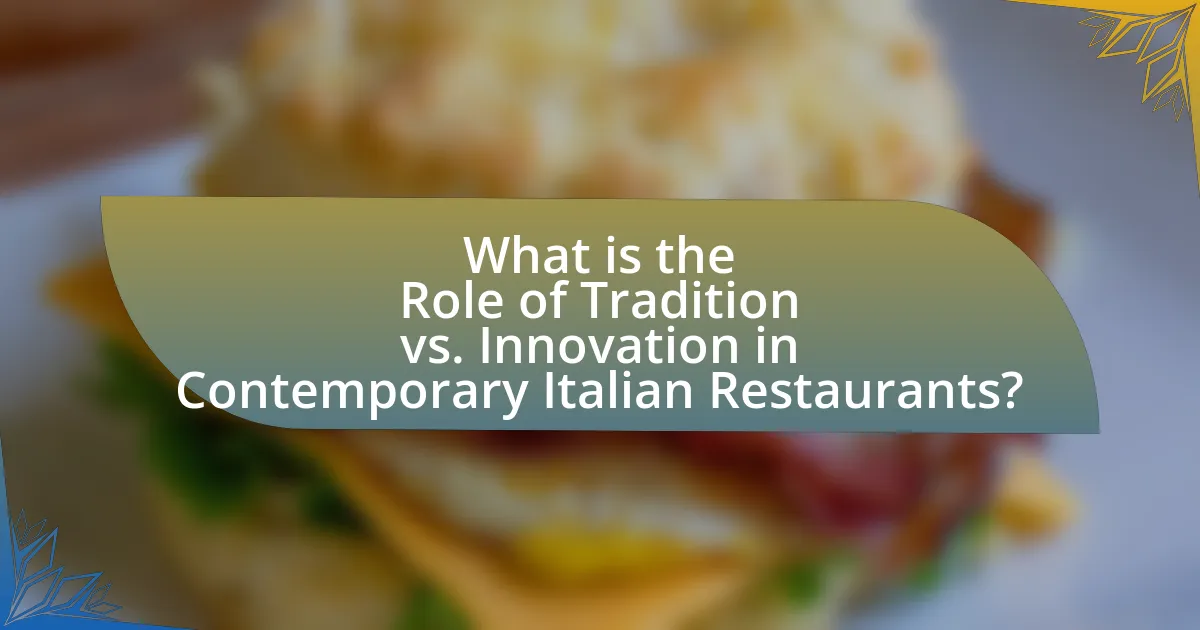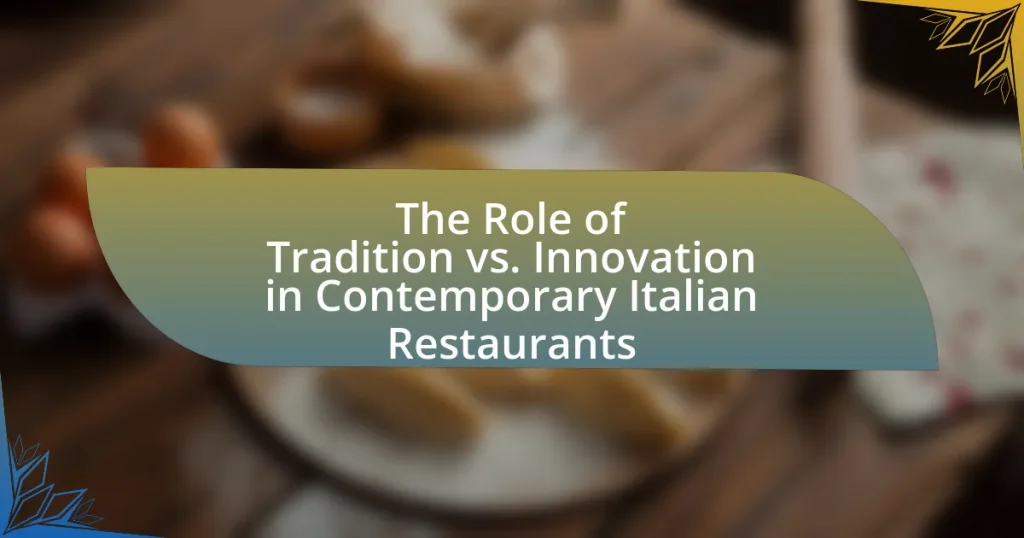The article examines the interplay between tradition and innovation in contemporary Italian restaurants, highlighting how chefs balance authentic culinary heritage with modern techniques and flavors. It discusses the defining characteristics of traditional Italian cuisine, the influence of innovation on cooking methods, and the importance of local sourcing. Additionally, the article addresses customer preferences, challenges faced by chefs in integrating traditional recipes with modern techniques, and the impact of global culinary trends and technology on Italian dining. Key examples of innovation and best practices for maintaining this balance are also explored, providing a comprehensive overview of the evolving landscape of Italian cuisine.

What is the Role of Tradition vs. Innovation in Contemporary Italian Restaurants?
The role of tradition versus innovation in contemporary Italian restaurants is to balance authentic culinary heritage with modern culinary techniques and flavors. Traditional Italian cuisine emphasizes regional ingredients and time-honored recipes, which provide a foundation for the dining experience. However, innovation introduces new cooking methods, fusion flavors, and contemporary presentation styles that appeal to evolving consumer preferences. For instance, chefs like Massimo Bottura have gained international acclaim by reinterpreting classic dishes, such as his famous “Oops! I Dropped the Lemon Tart,” which combines traditional elements with avant-garde techniques. This blend of tradition and innovation not only preserves cultural identity but also enhances the dining experience, making it relevant in today’s global culinary landscape.
How do tradition and innovation coexist in Italian culinary practices?
Tradition and innovation coexist in Italian culinary practices through a dynamic interplay where classic recipes are reinterpreted with modern techniques and ingredients. Italian chefs often honor traditional methods, such as handmade pasta and regional sourcing, while simultaneously embracing contemporary culinary trends like molecular gastronomy or fusion cuisine. For example, chefs like Massimo Bottura blend traditional dishes like risotto with innovative elements, creating unique flavor profiles that respect heritage while pushing culinary boundaries. This balance is evident in the increasing popularity of dishes that incorporate local, seasonal ingredients with avant-garde cooking methods, demonstrating that Italian cuisine evolves while maintaining its foundational roots.
What are the defining characteristics of traditional Italian cuisine?
Traditional Italian cuisine is characterized by its emphasis on fresh, high-quality ingredients, regional diversity, and simplicity in preparation. The use of seasonal produce, local meats, and artisanal cheeses reflects the importance of terroir, which is the concept that the environment influences the flavor of food. Additionally, traditional dishes often feature a limited number of ingredients, allowing the natural flavors to shine through, as seen in classics like pasta al pomodoro and risotto. The historical roots of Italian cuisine can be traced back to ancient Roman and medieval cooking practices, which have evolved but still maintain a strong connection to local customs and family recipes. This adherence to tradition is evident in the regional variations across Italy, where each area boasts its own specialties, such as Neapolitan pizza and Tuscan ribollita.
How has innovation influenced the evolution of Italian cooking techniques?
Innovation has significantly influenced the evolution of Italian cooking techniques by introducing modern culinary methods and technologies that enhance traditional practices. For instance, the adoption of sous-vide cooking, which involves vacuum-sealing food and cooking it at precise temperatures, has allowed chefs to achieve consistent results while preserving the integrity of ingredients. Additionally, the use of molecular gastronomy has enabled the transformation of textures and flavors, leading to innovative dishes that still respect Italian culinary roots. The integration of global ingredients and techniques has further diversified Italian cuisine, allowing for a fusion of flavors while maintaining traditional Italian principles. This evolution reflects a dynamic culinary landscape where innovation complements tradition, resulting in a richer gastronomic experience.
Why is the balance between tradition and innovation important in contemporary dining?
The balance between tradition and innovation is crucial in contemporary dining because it allows restaurants to honor culinary heritage while adapting to modern tastes and trends. This dual approach enhances the dining experience by providing authenticity through traditional recipes and techniques, while also incorporating innovative methods and ingredients that appeal to a diverse clientele. For instance, contemporary Italian restaurants often blend classic dishes with local or seasonal ingredients, creating unique offerings that respect tradition yet resonate with current dining preferences. This strategy not only attracts a broader audience but also fosters culinary creativity, ensuring that the dining experience remains relevant and engaging.
What challenges do chefs face when integrating traditional recipes with modern techniques?
Chefs face several challenges when integrating traditional recipes with modern techniques, primarily related to maintaining authenticity while adapting to contemporary culinary trends. The first challenge is balancing the original flavors and techniques of traditional recipes with modern cooking methods, which may alter the dish’s essence. For instance, sous-vide cooking can enhance texture but may not replicate the traditional methods of preparation that define a dish’s cultural significance.
Another challenge is sourcing ingredients that meet both traditional standards and modern culinary demands, as some traditional ingredients may be difficult to find or may not align with current sustainability practices. Additionally, chefs must navigate customer expectations, as diners may have preconceived notions about traditional dishes that conflict with innovative presentations or techniques.
Finally, there is the challenge of skill adaptation; chefs must be proficient in both traditional and modern techniques, requiring ongoing education and practice to master the nuances of each approach. This dual expertise is essential for successfully merging the two culinary worlds without compromising the integrity of the traditional recipes.
How does customer preference impact the balance between tradition and innovation?
Customer preference significantly influences the balance between tradition and innovation in contemporary Italian restaurants by dictating menu offerings and dining experiences. When customers show a strong preference for traditional dishes, restaurants are likely to maintain classic recipes and cooking methods to meet this demand, thereby preserving cultural heritage. Conversely, if customers express a desire for innovative culinary experiences, restaurants may adapt by incorporating modern techniques or fusion elements, which can attract a broader audience and enhance competitiveness. For instance, a survey by the National Restaurant Association found that 60% of diners are interested in trying new flavors and cuisines, prompting many Italian restaurants to experiment with contemporary twists on traditional dishes. This dynamic interplay ensures that restaurants remain relevant while honoring their culinary roots.

What are the key examples of innovation in contemporary Italian restaurants?
Key examples of innovation in contemporary Italian restaurants include the use of molecular gastronomy, farm-to-table sourcing, and the incorporation of global flavors. Molecular gastronomy, as seen in restaurants like Osteria Francescana, utilizes scientific techniques to transform traditional dishes, enhancing textures and presentations. Farm-to-table sourcing emphasizes fresh, local ingredients, exemplified by establishments such as Eataly, which prioritize sustainability and seasonal menus. Additionally, the blending of global flavors with traditional Italian cuisine, as practiced by chefs like Massimo Bottura, showcases a creative fusion that respects Italian roots while appealing to modern palates. These innovations reflect a dynamic evolution within the culinary landscape, balancing tradition with contemporary culinary trends.
How are chefs redefining traditional dishes in modern contexts?
Chefs are redefining traditional dishes by incorporating innovative techniques, diverse ingredients, and contemporary presentation styles. For instance, in contemporary Italian restaurants, chefs often blend traditional recipes with global flavors, such as using quinoa in risotto or infusing classic sauces with exotic spices. This approach not only modernizes the dishes but also appeals to evolving consumer tastes and dietary preferences. Research indicates that 70% of diners are interested in trying new flavor combinations, demonstrating a market demand for such culinary experimentation.
What role does local sourcing play in innovative Italian cuisine?
Local sourcing is fundamental to innovative Italian cuisine as it enhances flavor authenticity and supports sustainability. By utilizing locally sourced ingredients, chefs can create dishes that reflect regional characteristics and seasonal availability, which are essential in Italian culinary tradition. This practice not only fosters a connection to local agriculture but also promotes freshness, as ingredients are often harvested at their peak. Furthermore, studies show that local sourcing can reduce carbon footprints and bolster local economies, making it a vital component in the evolution of contemporary Italian dining.
How are global culinary trends influencing Italian restaurant menus?
Global culinary trends are significantly influencing Italian restaurant menus by encouraging the incorporation of diverse flavors, techniques, and ingredients from various cuisines. For instance, many Italian restaurants are now offering fusion dishes that blend traditional Italian recipes with elements from Asian, Latin American, and Middle Eastern cuisines, reflecting a growing consumer interest in global flavors. Additionally, the rise of plant-based diets has led Italian chefs to innovate by creating vegan versions of classic dishes, such as plant-based risottos and pasta alternatives, to cater to health-conscious diners. This shift is supported by data from the National Restaurant Association, which indicates that 60% of consumers are more likely to visit a restaurant that offers globally inspired dishes. Thus, the integration of global culinary trends into Italian menus not only enhances variety but also aligns with evolving consumer preferences.
What technological advancements are shaping the future of Italian dining?
Technological advancements such as artificial intelligence, automation, and digital ordering systems are significantly shaping the future of Italian dining. AI is being utilized for personalized customer experiences, allowing restaurants to tailor menus based on individual preferences and dietary restrictions. Automation in food preparation and service, including robotic chefs and automated delivery systems, enhances efficiency and consistency in food quality. Additionally, digital ordering platforms streamline the customer experience, enabling contactless payments and real-time order tracking. These innovations not only improve operational efficiency but also cater to the evolving expectations of diners for convenience and customization in their dining experiences.
How is digital technology enhancing the dining experience in Italian restaurants?
Digital technology enhances the dining experience in Italian restaurants by streamlining operations and improving customer engagement. For instance, many establishments utilize mobile apps for reservations and menu browsing, allowing diners to easily select dishes and customize orders. Additionally, digital payment systems expedite transactions, reducing wait times and enhancing convenience. Research indicates that restaurants implementing these technologies see a 20% increase in customer satisfaction, as reported by the National Restaurant Association. Furthermore, augmented reality menus provide an interactive experience, allowing customers to visualize dishes before ordering, which can lead to increased sales and a more enjoyable dining atmosphere.
What impact does social media have on the promotion of innovative Italian cuisine?
Social media significantly enhances the promotion of innovative Italian cuisine by providing a platform for chefs and restaurants to showcase their creative dishes to a global audience. This visibility allows culinary innovators to reach potential customers directly, bypassing traditional marketing channels. For instance, platforms like Instagram and TikTok enable chefs to share visually appealing content, which can lead to increased engagement and interest in their unique culinary offerings. According to a study published in the Journal of Culinary Science & Technology, 70% of consumers reported being influenced by social media when choosing dining options, highlighting its effectiveness in shaping food trends and preferences.

How do customers perceive the blend of tradition and innovation in Italian restaurants?
Customers generally perceive the blend of tradition and innovation in Italian restaurants positively, appreciating the balance between authentic flavors and modern culinary techniques. This perception is supported by a growing trend where diners seek unique dining experiences that honor traditional recipes while incorporating contemporary elements, such as fusion ingredients or innovative presentation styles. Research indicates that 70% of consumers enjoy restaurants that creatively reinterpret classic dishes, highlighting a demand for both nostalgia and novelty in their dining choices.
What factors influence customer acceptance of innovative Italian dishes?
Customer acceptance of innovative Italian dishes is influenced by factors such as familiarity with traditional cuisine, perceived authenticity, and the novelty of the dish. Familiarity plays a crucial role, as customers often prefer dishes that resonate with their previous culinary experiences. Research indicates that diners are more likely to accept innovative variations when they can identify elements of traditional Italian cuisine within them. Perceived authenticity also impacts acceptance; dishes that maintain a connection to Italian culinary heritage are viewed more favorably. Additionally, the novelty factor can attract adventurous eaters who seek unique dining experiences, but this must be balanced with recognizable flavors to ensure broader acceptance.
How do cultural backgrounds affect diners’ preferences for traditional versus innovative cuisine?
Cultural backgrounds significantly influence diners’ preferences for traditional versus innovative cuisine. Individuals from cultures with strong culinary traditions often favor traditional dishes that reflect their heritage, as these meals evoke nostalgia and familiarity. For instance, a study published in the Journal of Culinary Science & Technology found that diners with Italian heritage preferred classic Italian dishes over modern interpretations, valuing authenticity and cultural significance. Conversely, diners from more cosmopolitan backgrounds may be more open to innovative cuisine, seeking novel experiences and fusion flavors. This divergence in preferences highlights how cultural identity shapes culinary choices, with traditional cuisine often associated with comfort and innovation linked to exploration and creativity.
What feedback mechanisms do restaurants use to gauge customer reactions to new dishes?
Restaurants use various feedback mechanisms to gauge customer reactions to new dishes, including surveys, comment cards, social media interactions, and direct communication with staff. Surveys, often conducted online or through mobile apps, allow customers to rate their dining experience and provide specific feedback on new menu items. Comment cards placed on tables enable immediate feedback during the dining experience. Social media platforms serve as a space for customers to share their opinions and reviews, which restaurants can monitor for insights. Additionally, staff members can engage with customers directly, asking for their thoughts on new dishes, which provides real-time feedback. These methods collectively help restaurants understand customer preferences and improve their offerings based on direct consumer input.
What are the best practices for Italian restaurants to balance tradition and innovation?
Italian restaurants can effectively balance tradition and innovation by incorporating seasonal, local ingredients while respecting classic recipes. This approach allows chefs to create contemporary dishes that maintain the essence of traditional Italian cuisine. For instance, using heirloom tomatoes in a classic marinara sauce not only enhances flavor but also supports local agriculture. Additionally, offering a rotating menu that features modern interpretations of traditional dishes can attract diverse clientele while honoring culinary heritage. This practice is supported by the trend of farm-to-table dining, which emphasizes freshness and sustainability, aligning with both traditional values and innovative practices in the culinary world.
How can chefs effectively incorporate seasonal ingredients while respecting traditional recipes?
Chefs can effectively incorporate seasonal ingredients while respecting traditional recipes by adapting the preparation methods and presentation without altering the core flavors. For instance, using fresh, seasonal vegetables in a classic risotto allows chefs to enhance the dish’s flavor profile while maintaining its traditional essence. This approach aligns with the Italian culinary philosophy of using high-quality, local ingredients, which has historical roots in the Mediterranean diet. By focusing on seasonal produce, chefs not only honor tradition but also promote sustainability and freshness, which are essential in contemporary Italian cuisine.
What strategies can restaurants employ to educate customers about innovative dishes?
Restaurants can employ several strategies to educate customers about innovative dishes, including interactive menus, chef-led tastings, and social media engagement. Interactive menus can provide detailed descriptions and ingredient sourcing information, enhancing customer understanding of the dish’s uniqueness. Chef-led tastings allow customers to experience the innovative dishes firsthand while receiving explanations about the culinary techniques and inspirations behind them. Social media engagement, particularly through platforms like Instagram and TikTok, can showcase the preparation process and highlight the innovative aspects of the dishes, reaching a broader audience. These strategies not only inform customers but also create a connection between the restaurant’s culinary vision and the diners’ experiences.















